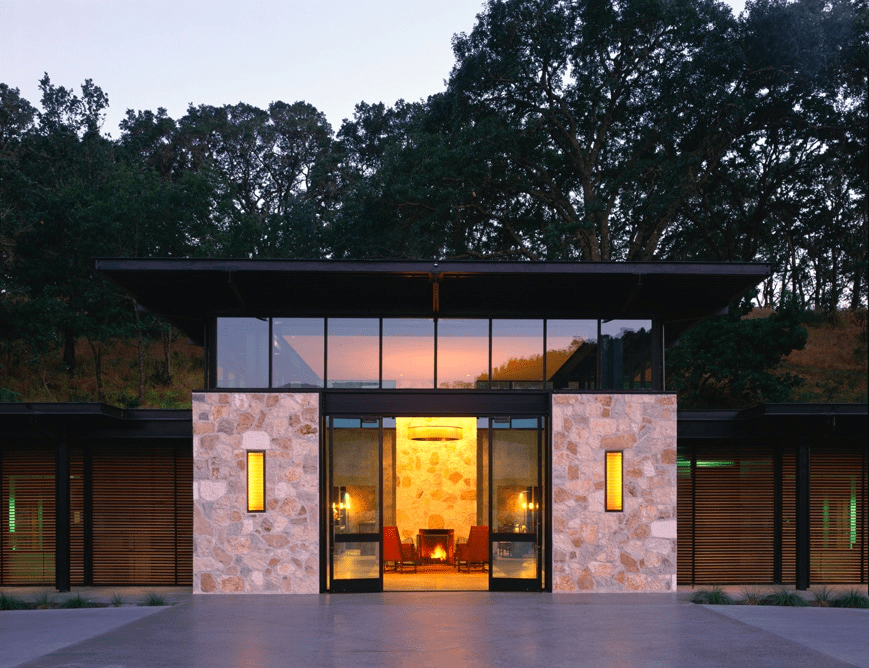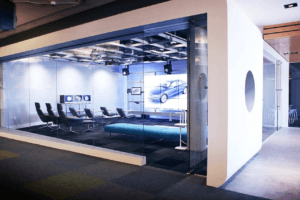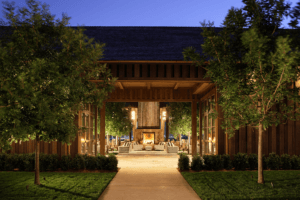As a world-class city, San Francisco is home to some of the best architects and architectural firms from across the globe. These decorated architects continue a long tradition in the city of pushing the field of architectural design forward. From Spanish Colonization, through the Gold Rush, multiple massive earthquakes, and numerous periods of rapid development, looking at city’s buildings and the men and women who designed them tells a fascinating story of the history of the city itself.
A Brief History of San Francisco Architecture
San Francisco is not known for one dominant style, but rather an eclectic mix that reflects the area’s history, geography, and diverse population.
The city’s history as Yerba Buena, a Spanish colonial port town, can be seen in some of its oldest buildings, such as Mission Dolores, and the original plaza of the Spanish settlement which remains as Portsmouth Square.
The Gold Rush resulted in a massive population boom shortly after the area was claimed by the U.S. and renamed San Francisco in 1847. This rapid growth complicated efforts to plan the city’s built environment, leaving the legacy of narrow streets that still prevail in many neighborhoods. Between 1860 and the 1880s, San Francisco transformed into a major metropolitan area. Neighborhoods were rapidly constructed in all directions of the center.
In the second half of the 19th century, many Greek Revival and Italianate Style buildings emerged, as did Gothic Revival structures, such as Old St. Mary’s church, built in 1853 by Chinese laborers. This is also when Victorian homes – the style with which San Francisco is perhaps most associated – became prominent. Indeed, between 1849 and 1915, about 48,000 houses in the Victorian and Edwardian styles were built in San Francisco. For example, in Presidio Heights, one of the city’s most exclusive neighborhoods, many homes date to between the 1900s to the 1930s and are Edwardian in style.
From 1906, extensive reconstruction was necessary after a massive earthquake and subsequent fire destroyed approximately 80% of the city, including almost all of downtown. Reconstruction was extensively planned and quickly enacted, influenced largely by famed urban planner, Daniel Burnham. This rebuilding period resulted in wider streets, a neo-classical civic center complex, and Arthur Brown Jr’s Coit Tower on Telegraph Hill. Master planned neighborhoods also appeared during this period, such as Seacliff in 1914, planned by landscape architect Mark Daniels. The Bungalow/Craftsman style homes for which California is known also proliferated across the city in this time. To showcase the city’s resurgence and recovery, it hosted the 1915 Panama–Pacific International Exposition in what is now the Marina District. Although this resulted in major construction projects by prominent architects, Maybeck’s Palace of Fine Arts is the only survivor of that era and the district is now known for being virtually unchanged since the homes were first constructed in the 1920s.
Later, the aggressive urban revival movement of the 1950s led to the leveling of entire areas in San Francisco’s Western Addition and Japantown neighborhoods and eventually resulted in the creation of Embarcadero Center, the Embarcadero Freeway, today’s Japantown, the Geary Street superblocks, and eventually, Yerba Buena Gardens.
The development boom, or the “Manhattanization,” of the 1980s produced many skyscrapers in the Financial District and high-rise condominiums in a variety of neighborhoods. This decade also saw major development projects, such as South of Market’s Moscone Center by architects Hellmuth, Obata & Kassabaum (HOK), a world-class design firm.
Today, San Francisco continues to see large population growth and urban development. Skyscrapers by world-famous architects are going up downtown at an incredible rate and new multi-family housing developments are being strategically planned in many neighborhoods, including the Tenderloin and the South of Market/Transbay area. As commercial business thrives, so too are the number of firms that focus on projects such as office design, hospitality, and urban planning. And given the city’s density, new residential builds are rare, meaning architects here are experts are creatively renovating and restoring historic properties.
Famous San Francisco Architects
If you walk around the city, you will see buildings and structures design by some architectural titans of today and the past.
The Bay Area has always been full of local design talent. In addition to attracting global architectural superstars, San Francisco has been the home to architects who changed not only the physical face of the region but also influenced the direction of the architectural field.
Willis Polk was one of San Francisco’s most influential architects and urban planners in the early 1900’s. He moved to the city to establish Chicago architect Daniel Burnham’s San Francisco office. With the firm, he designed some of his most significant structures, including the 1903 Merchants Exchange Building, the tallest building in the city at completion. Later, he again designed the new tallest building in San Francisco, the 1914 Hobart Building. Polk was a member of Mayor Eugene Schmitz’s Committee of Fifty, a group of leaders who undertook ambitious plans to rebuild San Francisco into a world-class city after the earthquake. And he was tasked with the reconstruction of Mission Dolores, which had been damaged. His incredible talent resulted in being appointed as the chair of the architectural planning committee for the 1915 Panama–Pacific International Exposition. Polk’s work continues to influence today’s architecture. His design was for the Hallidie Building, built around 1917/18, was one of the first American buildings to feature a glass curtain facade, considered the precursor to the modern skyscraper.
Bernard Maybeck was one of the city’s most prominent architects and a forerunner in the Arts and Crafts Movement. In the early 20th century, he designed some of the Bay Area’s most famous buildings served as a mentor to many of California’s most important architects, including Julia Morgan and William Wurster. Incredibly versatile, Maybeck believed that each architectural problem required a unique solution. As such, his work ranges from Mission and Mission Revival style to Gothic revival, Arts and Crafts, and Beaux-Arts classicism. His notoriety resulted in an invitation to design the 1915 Palace of Fine Arts for the Panama-Pacific International Exposition. Many of Maybeck’s works are on the National Register of Historic Places. His 1910 First Church of Christ, Scientist in Berkeley is a National Historic Landmark and in 1928 at 1010 Gough Street he built what is still the home of the Family Service Agency of San Francisco, which is on the city’s Historic Building Registry. In addition to his extensive commercial work, Maybeck also designed numerous homes, including many large ones in Berkeley.
Timothy Ludwig Pflueger was a prominent Bay Area architect and interior designer in the first half of the 20th century. Born in Potrero Hill to German immigrants, he designed his first building in 1912 at the age of just twenty – Our Lady of the Wayside Church, now a California Historical Landmark. With James R. Miller, Pflueger went on to design some of the leading skyscrapers and movie theaters in San Francisco in the 1920s. They designed the 1925 Pacific Telephone & Telegraph Co. Building, which was the tallest building in San Francisco for the next 40 years. Pflueger also designed the San Francisco Stock Exchange building in 1923 – a designated San Francisco Landmark. Although he played a hand in the development of Art Deco in California, he worked in many styles, including Streamline Moderne, neo-Mayan, Beaux-Arts, Mission Revival, Neoclassical, and International. He was incredibly active in the San Francisco Architectural Club, including being chosen director in 1914 and president in 1921 after becoming a certified California architect. He was also heavily involved in several important local planning organizations, including as the chairman of a committee of consulting architects on the Bay Bridge project and serving on the committee responsible for the design of the 1939 Golden Gate International Exposition.
William Wurster designed dozens of residences across the city of San Francisco from the 1920s through the 1940s. Another California native, Wurster was mentored by Bernard Maybeck. He was known for his use of indigenous materials and a direct, simple style that was particularly suited to the northern California climate. In particular, Wuster excelled in building small Depression-era homes that gave their residents the impression that the homes were larger than they were. He served as the dean of the UC Berkeley Architecture school and was an architectural teacher at MIT. At the University of California, Berkeley, Wurster co-founded, with Joseph Esherick, T.J Kent, Catherine Bauer, and Vernon DeMars, the College of Environmental Design (CED), which combines the disciplines of architecture, landscape architecture, environmental planning, and city planning.
Joseph Esherick had a storied career spanning residential, commercial, and sustainable design in the second half the 20th century. He built a reputation for site-specific buildings that blended into their surroundings and were tailored to their occupant’s needs. He began his architectural practice in the Bay Area as early as 1950. Continuing the tradition of Wurster and Maybeck, Joseph Esherick designed hundreds of houses with people-friendly designed focused on regional tradition. Esherick taught at the University of California, Berkeley for more than 40 years. After a successful career in residential design, Esherick shifted focus in 1972 towards academic and commercial work, forming Esherick Homsey Dodge & Davis with three lifelong associates, George Homsey, Peter Dodge and Chuck Davis. The practice won the 1986 Architecture Firm Award and continues today as EHDD Architecture – listed on our Best Green Architects list. In 1976, Esherick was elected into the National Academy of Design as an Associate member in 1976 and became a full Academician in 1990.In 1989 Esherick received the AIA Gold Medal.
Other Famous Architects in San Francisco
- A.C. Schweinfurth, for example, was associated with the First Bay Tradition and his 1890’s Hacienda del Pozo de Verona was one of the first American buildings to incorporate features of Pueblo Revival architecture.
- And Bay Area native Henry Clay Smith demonstrated an incredible talent for designing buildings specifically for the city’s hilly terrain.
- Notable San Francisco architects such as Julia Morgan, A.C. Schweinfurth, and McDonald & Applegarth designed some of the most graceful and celebrated turn-of-the-century structures in the Bay Area.
- The Reid Brother’s legacy can be seen in Oakland’s Grand Lake Theater, the 1906 Fairmont Hotel San Francisco, designed with Julia Morgan, and The Garfield Building, a great example of the types of structure built in the post-earthquake period.
- Similarly, shingle-styled buildings scattered around the city by of Ernest Albert Coxhead, who was deeply involved in the emergence of the Arts and Crafts style, continue to be a source of inspiration for today’s architects.
San Francisco has attracted prominent architects from around the world to design some of its most important and groundbreaking buildings over the past century.
- Frank Lloyd Wright designed the 1949 Circle Gallery with an interior spiral, a convention he later employed in New York’s Guggenheim Museum.
- Arthur Gensler is responsible for many local projects, beginning in 1982 when he worked with Helmuth, Obata & Kassabaum and Howard Friedman to design the Levi corporate headquarters.
- San Francisco is also home to Swiss Architect Mario Botta’s magnificent Museum of Modern Art, built in 1995.
- And the city has a new Federal Building designed by Los Angeles-based architect Thom Mayne, who was the 2005 Pritzker Architectural Prize-winner.
- Italian architect Renzo Piano designed the 2008 California Academy of Sciences, with a massive green roof and indoor rainforest.
- Major projects are now underway or on the drawing boards by major Starchitects, including Foster + Partners’ two towers at 50 First Street and Cesar Pelli’s Transbay Tower.
Architects in San Francisco Today
Today, architects continue to thrive in the Bay Area. The American Institute of Architects, San Francisco Branch which has served the Bay Area for almost 150 years has grown to be one of the largest of the 220+ AIA Chapters in the country given the strong history and success of the city’s architectural community. Currently, AIA SF has 2,345 members, including 170 AIA Fellows. There are over 500 active architectural firms practicing in the Bay Area.
These architects and firms work on all types of projects. As a world-class city, San Francisco has attracted the top architects working on everything from commercial to residential work, and everything in between. Here at SF Architects, we have researched thousands of architects and hundreds of these firms to select the best in the following categories:
COMMERCIAL – As an international hub of commercial activity, it is no surprise that San Francisco hosts or is home to some of the most decorated architectural firms and Starchitects across the globe. From skyscrapers designed by Renzo Piano to a new stadium by the global practice Snøhetta, this city attracts the best. Our list of the 15 Best Commercial Architects working in the city right now includes homegrown powerhouses and international superstars.
OFFICE – Home to some of the world’s most recognizable, profitable, and fastest-growing companies, office architects are in high demand in Bay Area. Our list of the 10 Best Office Architects looks at the men and women building perhaps the most inspired workspaces in the world, including campuses for Facebook, Yahoo!, and Linkedin, high-tech headquarters for Airbnb, Twitter, and Dropbox, to unbelievable offices for Uber, Yelp, Pandora, and Microsoft.
RESTAURANT – San Francisco is becoming increasingly known for its excellent culinary scene. And every top restaurant deserves a beautifully designed space to highlight its food. The 10 Best Restaurant Architects have impressive portfolios of award-winning bars, lounges, and restaurants across the city.
RESIDENTIAL — The natural landscape of San Francisco, with its rolling hills and surrounding water, provide a defined and limited canvas for innovative and creative architects. Steep sites create a test of technical abilities for the city’s architects, and with few opportunities for new builds, these architects are called upon to creatively renovate classic, often narrow residences to adapt to current preferences. The 15 Best Residential Architects in the city have overcome these challenges and risen above the crowd.
INTERIOR DESIGN – Given the high caliber of the city’s residential architects, it only makes sense then that the region would also be home to top-of-the-line interior designers to make these spaces into the perfect homes. So we looked at hundreds of firms to pick out the 10 Best Residential Interior Designers.
BEST DESIGN + BUILD FIRMS – Many of San Francisco firms and homeowners have embraced a new model of construction, whereby clients hire one company to handle their residential projects from design through construction. The seven practices on our list of the Best Design + Build Firms are leading the pack of this new ‘one-stop-shop’ method.
MULTI-FAMILY HOUSING – With a population growing as rapidly as that in San Francisco, building sufficient housing is important, but difficult, task. The 11 architects on our Best Multi-Family Housing Architects list have skillfully designed projects that match and scale and style of their neighborhoods, contribute to the built environment and allow for future growth. They have added townhomes, luxury skyrise condominiums, student housing, and everything in between in neighborhoods across the city.
LOW-INCOME HOUSING – Hand-in-hand with multi-family housing is housing projects for the city’s poorest and disadvantaged populations. In a city that is becoming increasingly expensive, this is an important subsector of the architectural field. And in many ways, the individuals included on our list of the Best Affordable Housing Architects are leading the country in creating innovative, productive, and dignified solutions to low-incoming housing.
GREEN – The 10 Best Green Architects in San Francisco have helped put the city at the forefront of sustainability and green building practices and made it into a testing ground for the newest green ideas. California is home to more winners of the AIA Committee on the Environment (COTE) Top Ten Awards than any other state, and many of them are in San Francisco.



